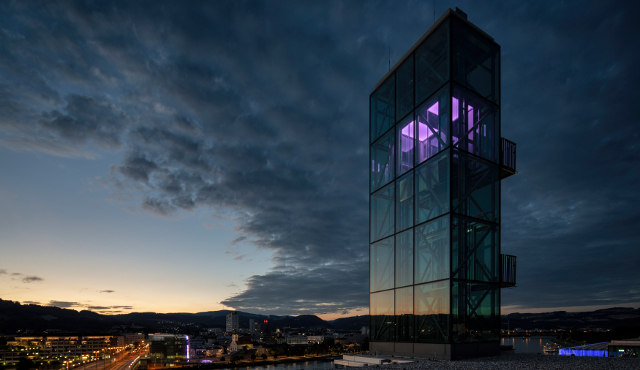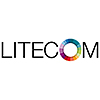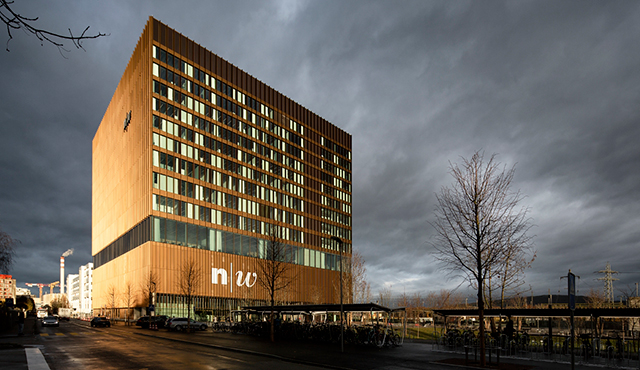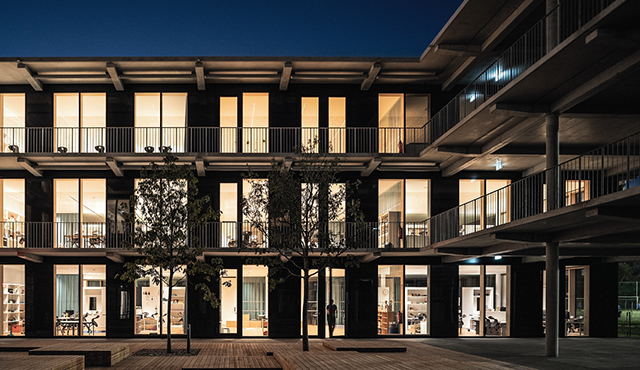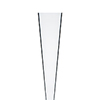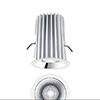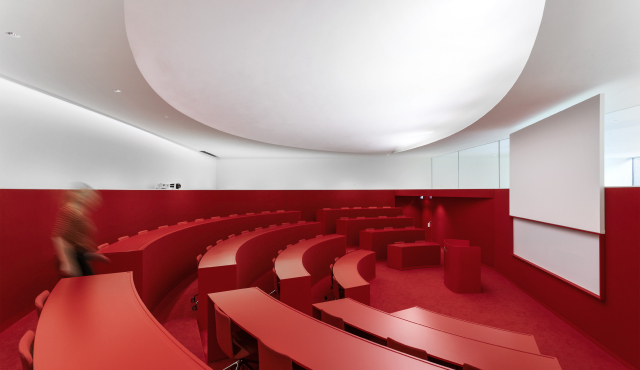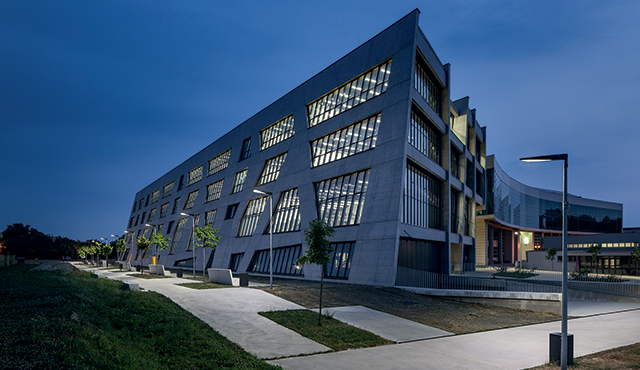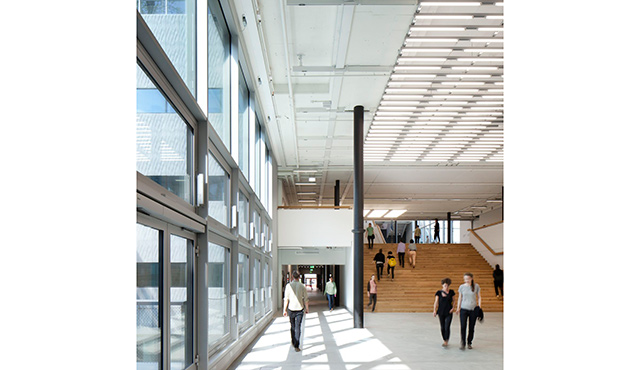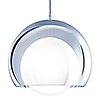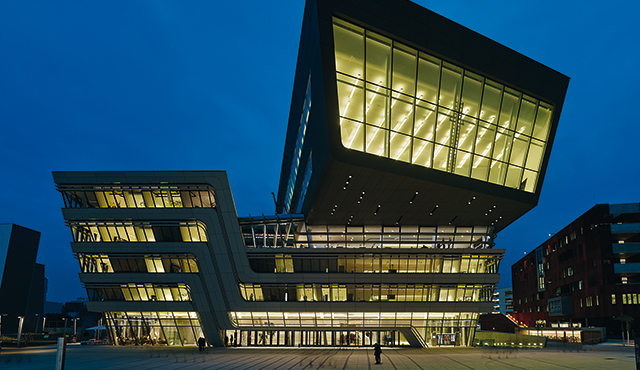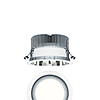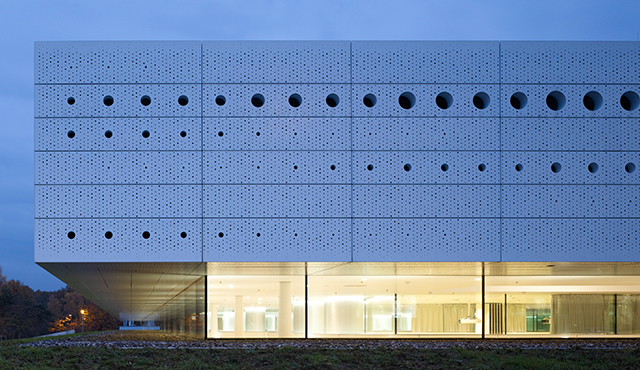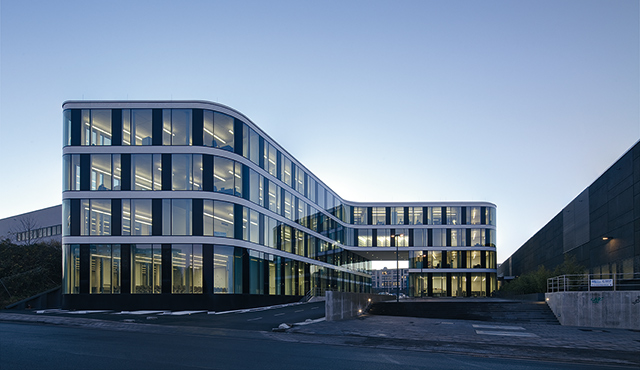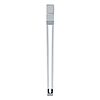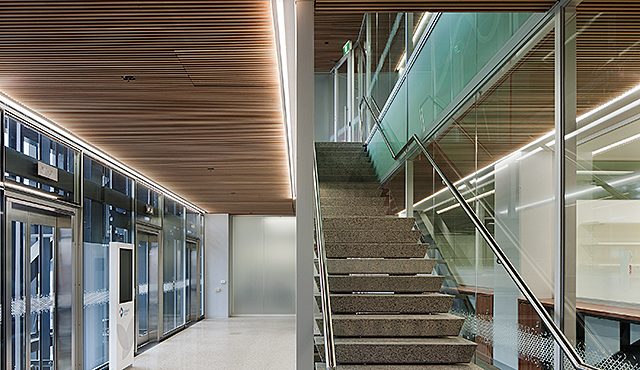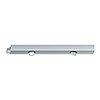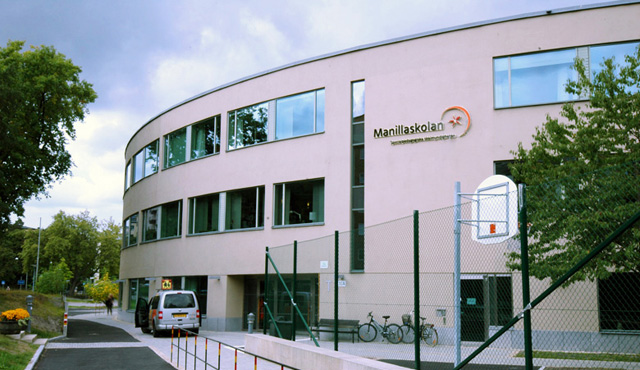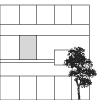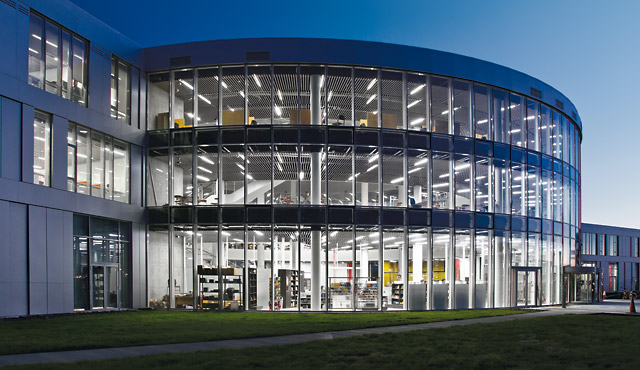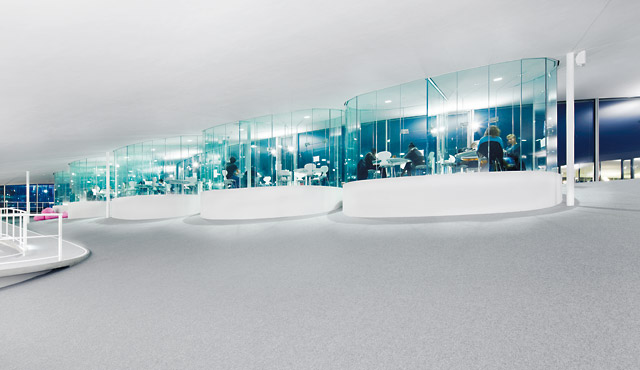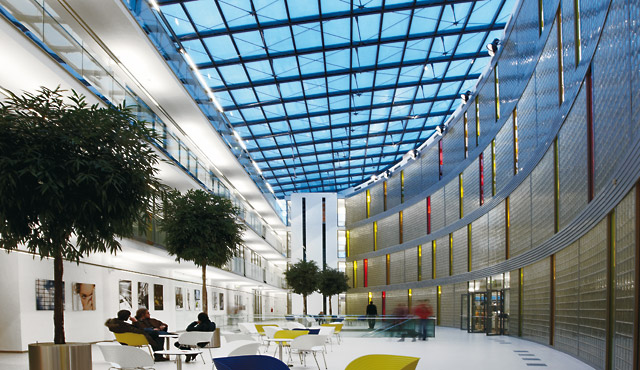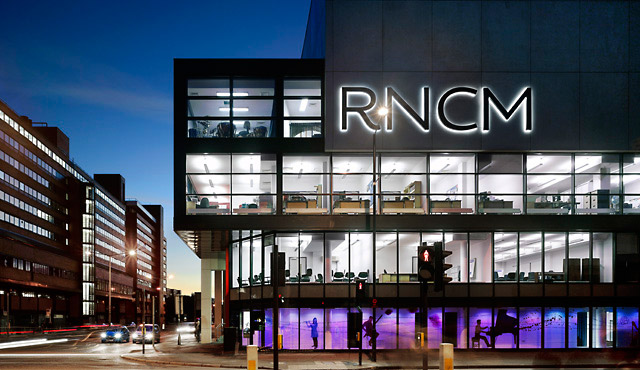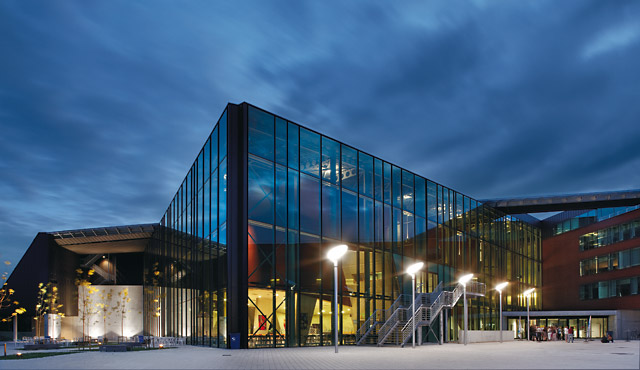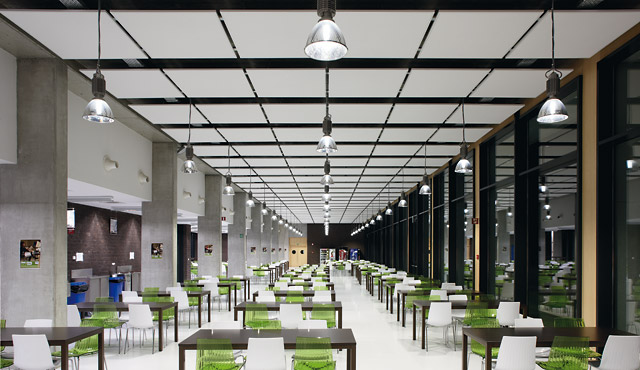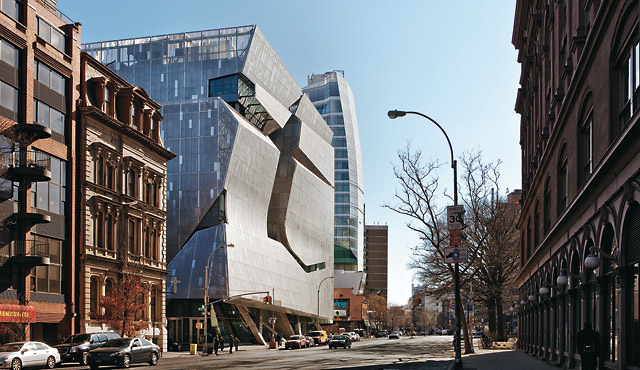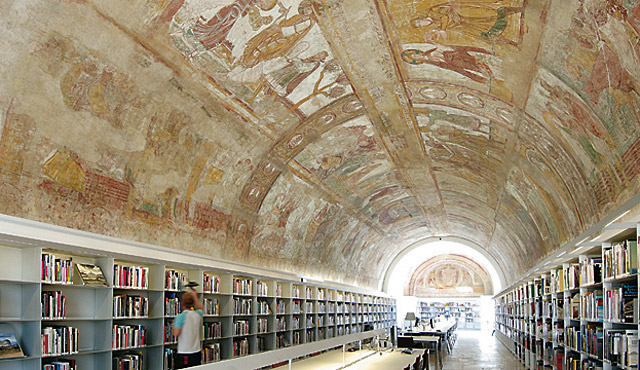
The aim of the complete refurbishment of the Sonthofen grammar school, which was built in the 1970s, was to upgrade the building to the corresponding energy level of a passive house. The interplay of daylight and artificial light is ensured by an intelligent lighting management system. The requirement was to ensure that the strict energy parameters do not impair general acceptance and user comfort. A study accompanying the refurbishment was carried out to clarify this.
Designing the schools of the future with Limbic® Lighting
How can light be used as a tool to support learning?
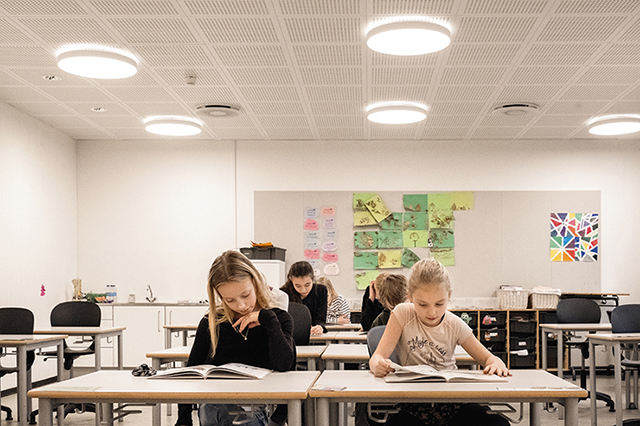
In a study at Aalborg University in Copenhagen, the interaction of light in schools was investigated using four lighting scenes. The following motivations for changing the light during learning emerged:
- Support and structuring of learning activities
- Communication via the lighting
- Involvement of schoolchildren in decision-making
- Influence on activity level and behaviour
- Creation of a special atmosphere adapted to the activities
- Support for visual tasks and improved visual comfort
The change of light offers a new interactive teaching tool that supports learning processes by changing the space.
» Click here for more detailed information on the school study by Aalborg University
New school building
Light combines architecture and new methods of teaching
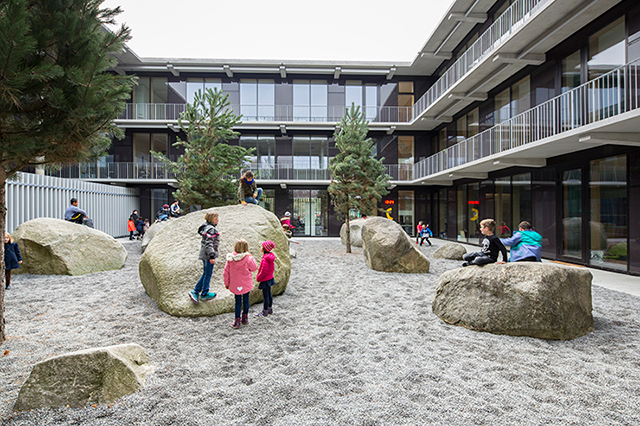
“It’s not the child who should adapt to the environment, it’s we who should adapt the environment to the child.”
Schule am See
Even the light adapts. A successful learning environment and school that is also an important communal meeting place requires participation that is supported by architects: incorporating the wishes of parents and children, an analysis of the teaching methods, attendance, observations, evaluating the requirements of associations and communities, regular meetings with teachers and local authorities, including during the construction phase. But above all, it’s the nine identical and flexible-use clusters with their innovative lighting concept that are now attracting international media representatives, educators and architects to Lake Constance.
» More on the Schule am See, Hard
School refurbishment
Convenient replacement of luminaires for efficiency and comfort
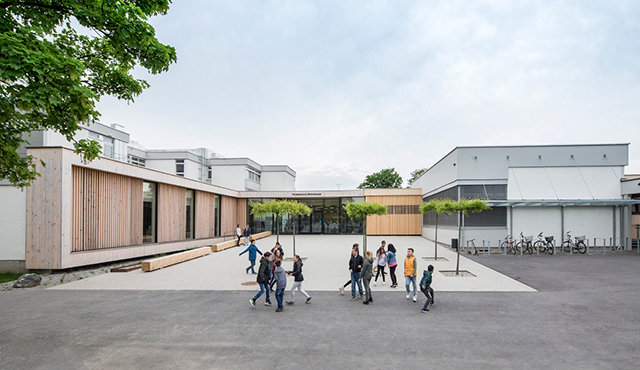
The Volksschule Herrenried (primary school) in Hohenems (Austria) is a fine example of an energy efficiency upgrade of a school building from the sixties, supplemented by a new wing. The then visionary learning environment still offers the perfect room structure for today’s teaching methods – for whole-class groups, group work or concentrated individual work with the freedom to choose the room and working speed. There is now no difference in quality between the existing three-storey class wing and the adjacent new building. The MIREL evolution luminaire family is the perfect choice for replacing lights in existing ceiling structures during refurbishment projects. However, it also integrates efficiently and without glare into the new building, without being obtrusive.
» More on the Volksschule Herrenried (primary school)
Product recommendations
Teaching areas |
||||||
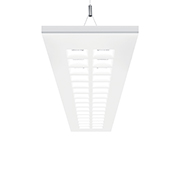 |
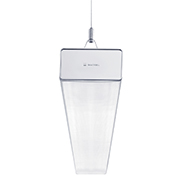 |
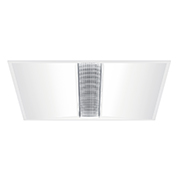 |
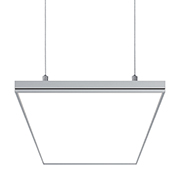 |
|||
| MIREL evolution | ECOOS | MELLOW LIGHT evolution / infinity | LIGHT FIELDS evolution | |||
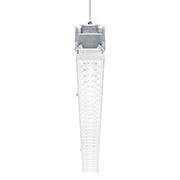 |
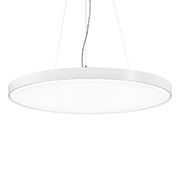 |
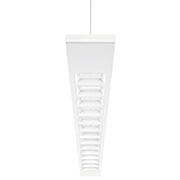 |
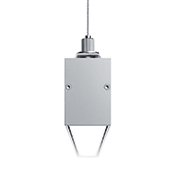 |
|||
| TECTON | ONDARIA | CLARIS evolution | SLOTLIGHT infinity slim | |||
Corridor and extension in the classroom |
Sports halls |
|||||
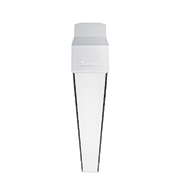 |
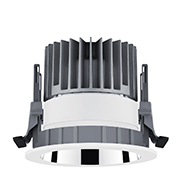 |
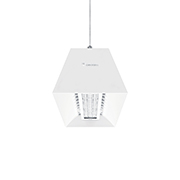 |
||||
| SLOTLIGHT infinity | PANOS infinity | CRAFT | ||||
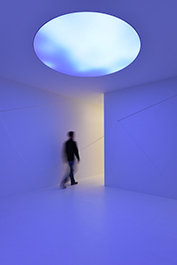
What does Limbic® Lighting mean and
what role does the room play?
Light supports dynamic learning activities by quickly adapting the atmosphere. It offers a highly emotional quality. Emotions triggered by people and spaces have a significant influence on our thinking and behaviour. For example, “polarisation of attention” as defined by pioneering educator Maria Montessori – playful abandon and complete immersion in the task – can be supported by environmental conditions. Positive emotions support the joy of discovering and learning, thus helping people to learn successfully.
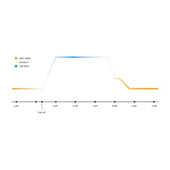
What is human-centric lighting
and how does it help pupils and teachers?
Human-centric lighting (HCL) supplements daylight to help students and teachers feel energised and revived. The right lighting composition at the right time supports natural physical processes throughout the day. The body clock is stabilised and quality of sleep is improved. For healthy and active learning. Decreasing the amount of time spent in nature has many harmful consequences for the organism. Teaching periods and break times outdoors, and generously sized windows supplemented by HCL artificial lighting solutions compensate for these deficits.
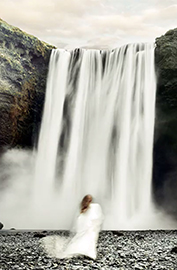
How can tunableWhite contribute to successful learning?
This technology supports people in two ways: Human-centric lighting supports the body’s physical processes. Activating and bluish light in the morning, reduced and reddish light in the evening. The objective of Limbic® Lighting, on the other hand, is emotion. Reddish light and a living room-like atmosphere encourage ideas. On the other hand, the room needs various sensory stimuli for different activities, which are provided by tunableWhite at the push of a button or in stored timelines.
References
-
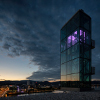 University of Arts Linz
University of Arts Linz
Linz, Austria -
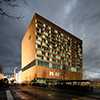 FHNW Campus
FHNW Campus
Muttenz, Switzerland -
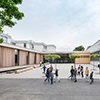 Volksschule Herrenried (primary school)
Volksschule Herrenried (primary school)
Hohenems, Austria -
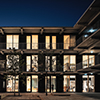 Schule am See
Schule am See
Hard, Austria -
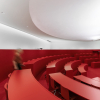 Mannheim Business School
Mannheim Business School
Mannheim, Germany -
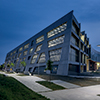 Faculty of Civil Engineering
Faculty of Civil Engineering
Osijek, Croatia -
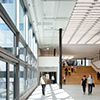 Toni-Areal
Toni-Areal
Zurich, Switzerland -
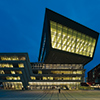 University of Economics and Business
University of Economics and Business
Vienna, Austria -
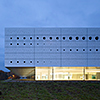 :envihab Institute for Aviation and Space
:envihab Institute for Aviation and Space
Cologne, Germany -
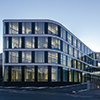 CMP – Center for Mobile Propulsion
CMP – Center for Mobile Propulsion
Aachen, Germany -
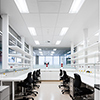 Peter Doherty Institute
Peter Doherty Institute
Melbourne, Australien -
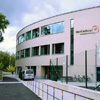 Manillaskolan
Manillaskolan
Stockholm, Sweden -
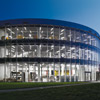 Reykjavik University
Reykjavik University
Reykjavik, Island -
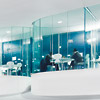 EPFL Rolex Learning Center
EPFL Rolex Learning Center
Lausanne, Switzerland -
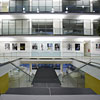 Tomá Bata University Centre
Tomá Bata University Centre
Zlín, Czech Republic -
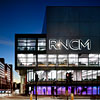 Royal Northern College of Music
Royal Northern College of Music
Manchester, England -
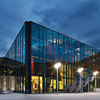 KHBO – Katholieke Hogeschool
KHBO – Katholieke Hogeschool
Brügge, Belgium -
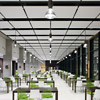 Gent University – Campus Schoonmersen
Gent University – Campus Schoonmersen
Gent, Belgium -
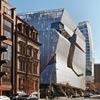 Cooper Union
Cooper Union
New York, USA -
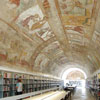 Cité d’Architecture et du Patrimoine
Cité d’Architecture et du Patrimoine
Paris, France
| Owner: | Bundes Immobilien Gesellschaft (AT) |
| Architect: | Architekt Krischanitz (AT) |
| Artist: | Karin Sander (DE) |
The Berlin-based artist Karin Sander has created an extraordinary exhibition space for students at the University of Art in Linz: a “transcendental elevator” that is simultaneously an artistic object, an appliance and an icon. With the help of Zumtobel, the elevator not only shines in varying colours way beyond the rooftops of the university, but can also be transformed into a real work of art by students.
Look up to the roof of the University of Art in the Upper Austrian city of Linz and you may at first be a little confused. Why exactly is a glass goods lift – a contraption that can be seen from far and wide – standing high above the roof of the university? It glows in a series of bold changing tones, sometimes brighter, sometimes darker. In fact, it almost seems to be sending signals to the sky. But why?
This creative construction project, which is presently catching everyone's eye in Linz, is the work of the artist Karin Sander. She has designed a hybrid known as the “transcendental elevator”. On the one hand, the purely functional goods lift is a shining symbol of the university – a symbol that can certainly be easily seen. For miles around. Yet at the same time, as well as housing a spectacular exhibition space, students can also turn the actual structure into a piece of modern art.
But first, let us start at the beginning. The prominent Viennese architects Architekt Krischanitz are currently refurbishing the various different sections of the University of Art and Design Linz. The recent completion of the eastern bridgehead building (Brückenkopfgebäude) on the Nibelungen Bridge marks the end of the first construction phase. Although the listed façades of the historic building have remained very much untouched, the architects have found a way of adding impressive lecture theatres under a glass roof structure. And they have used a new lighting design concept to emphasise the imposing stairwells. Artist Karin Sander, representatives from Architekt Krischanitz and the client BIG (as part of their BIG ART construction & art programme) all worked closely with Zumtobel to realise the transcendental elevator project.
The Zumtobel team set about developing a vibrant lighting installation – in every sense. In stark contrast to the small amount of space available, this solution makes a big impression by immersing the elevator in all the colours of the spectrum. The demands were high. Very high, in fact. As an artistic object, this project required a lighting system that could offer students the greatest possible creative freedom. Yet as a practical goods lift, the specified components also had to be fit for purpose. A frameless illuminated ceiling from Zumtobel managed to hit both of these targets. The intensity and the colour of the light can be easily modified using a controls solution that contrasts maximum flexibility with minimal complexity: LITECOM from Zumtobel. As a result, all the necessary parameters can be perfected and programmed according to the specific needs of the students or staff. Just how they want it.
Design from the past with the technology of today: The ALVA spherical luminaire from Hermann Czech and Adolf Krischanitz
The transcendental elevator is not the only special feature associated with this construction project. Visit the University of Art and you will discover a true design gem: the ALVA spherical luminaire. Based on an idea from Hermann Czech that originally dates back to the 1960s, this fitting was first designed together with Adolf Krischanitz during the 1990s. Now Zumtobel and the Architekt Krischanitz studio have refreshed this concept for „the editions" – a special collection in more ways than one. ALVA gives the university illustrious sparkle. The light spheres float like heavenly bodies in the hallways, accentuating the impressive staircase and the elegant cafeteria. “A key reason for the beauty of the luminaire is the fact that the technology is hidden. Zumtobel immediately developed two versions that fulfilled our requirements,” explained Stefan Just, Project Manager at Architekt Krischanitz.
The more complex version features a glass sphere that is open at the bottom and the top. The glare-free light is provided in three ways: from an LED downlight and an LED uplight, as well as via spherical illumination of the whole fitting – without any shading caused by the technology. The simpler version sacrifices the direct beam of the downlight for a completely closed glass housing that indirectly delivers diffuse spherical light.
Flexible systems for study and work spaces
Zumtobel was able to use its extensive lighting expertise for more than just the special solutions and customised developments. After all, this kind of establishment also needs light that promotes learning and supports quality of vision throughout the university. That is why Architekt Krischanitz opted for the highly versatile TECTON continuous-row system. A crucial aspect is the interplay between the dimmable TECTON MPO luminaires and the LED spotlights, which ensure excellent glare control to make them the ideal choice for lecture theatres and seminar rooms. The company managing the publicly owned real estate (the Bundesimmobiliengesellschaft or BIG) used the renovation of the site to switch completely to efficient LED technology and thereby achieve their goal of sustainable operation.
Zumtobel and modern art
Zumtobel has been associated with contemporary art projects for decades now. And not just as a supporter, but also as an active partner for the implementation of highly complex installations – just like the joint “Skyspace” project by the Austrian lighting specialist and James Turrell in Lech am Arlberg. This underground light room in the middle of the Alpine landscape of Vorarlberg, the home county of Zumtobel, opened in September 2018.
Zumtobel. The Light.
share it
| Owner: | Hochbauamt Basel-Landschaft, Fachhochschule Nordwestschweiz, Muttenz (CH) |
| Architect: | pool Architekten, Zürich (CH) |
| Lighting design: | Reflexion AG, Zürich (CH) |
| Electrical consultants: | Pro Engineering AG, Basel (CH) |
“The architecture of the new building is extremely compelling and has a strong graphic quality,” says Thomas Mika, managing director of Reflexion, who is responsible for the lighting concept of the university building. “So we decided to integrate all the luminaires into the structural elements as much as we could.” Diverse daylight situations create different atmospheres and room impressions. The ribbed concrete ceilings define the office, seminar and laboratory rooms as well as the corridors of the new university building from the third to the twelfth floor. Reflexion decided to insert a linear luminaire between each of the ribs so that the rooms benefit from uniform light and good luminance distribution. However, the lighting designers didn’t want a simple, two-dimensional continuous row, instead they aimed for a substantial, three-dimensional light that would illuminate the architecture and at the same time serve as lighting for the workplaces.
Two models of the FREELINE have been created along these lines. While one model is suitable for office and classroom applications thanks to the MPO’s precise light control, the other is equipped with lenticular optics. This entails light deflection for asymmetrical light distribution: ideal for emphasising architecture, e.g. as wall washer or panel lighting, as in the seminar rooms at the FHNW Campus Muttenz.
It wasn’t just the elegant, graphic design and the flexible use of the luminaire that impressed the building owners, but also the simple installation – the FREELINE is simply inserted on a low-voltage track. This means that specially trained personnel are not required during installation. An important factor after all, as the university wanted to move into the premises for the 2018/19 winter semester. Fast, uncomplicated installation was therefore just as essential as the large quantities that Zumtobel was able to supply in the shortest possible development and production time.
Zumtobel. The Light.
share it
-
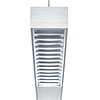 FREELINE
FREELINE
| Owner: | Stadt Hohenems Immobilienverwaltungs-GmbH & Co.KG, Hohenems (AT) |
| Architect: | Dorner\Matt Architekten, Bregenz (AT) |
| Lighting design: | Licht Innovativ GmbH, Innsbruck (AT) |
| Electrical consultants: | IHM Elektrotechnik, Hörbranz (AT) |
| Electrical installations: | Elmar Graf GmbH, Dornbirn (AT) |
The renovated classrooms in the school in Hohenems are in no way inferior to the quality of the new building, and certainly not when it comes to light. Using the ceiling grid of the existing lighting system, it was possible to replace all the existing louvre luminaires with fluorescent lamp technology in the refurbished rooms. The MIREL evolution recessed luminaire was used here as an LED lens variant. The overall package of the luminaire family and the large number of variants in a uniform design are ideally suited to the requirements of the school environment, in both renovations and in new buildings. The stricter minimum requirements for classrooms that are also used in the evening were exceeded. The average maintained illuminance is now over 500 lx. In this building, the MIREL evolution family proves to be an integral and imperceptible part of the architecture. Supplementary panel lighting also ensures perfect contrasts on the vertical surfaces.
In the hallway, the old seamlessly transitions to the new. The MIREL evolution with opal optic creates an openness similar to a daylight opening – perfect for zones that feel closed off because they do not look out into the natural environment. This friendly room feel is reinforced by the square 2LIGHT Mini downlights, which are positioned close to the wall and create a brilliant appearance.
It was also possible to replace all the old louvre luminaires in the sports hall lighting using a project lighting solution. The new luminaires supplement the daylight and meet all requirements for glare, lighting level, uniformity and ball impact resistance. The extended periods of use by clubs in the evenings mean short amortisation periods for the new lighting solution.
Zumtobel. The Light.
share it
-
 MIREL evolution
MIREL evolution
-
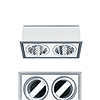 2LIGHT
2LIGHT
-
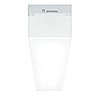 PERLUCE
PERLUCE
| Owner: | Marktgemeinde Hard, Hard (AT) |
| Architect: | Baumschlager Hutter Partners, Dornbirn (AT) |
| Lighting design: | Bartenbach GmbH, Aldrans (AT) |
| Electrical consultants: | Ingenieurbüro Brugger GmbH, Thüringen (AT) |
| Electrical installations: | Elmar Graf GmbH, Dornbirn (AT) |
The extremely streamlined, white line luminaires in a uniform louvre appear as precisely integrated, structuring strips in the acoustic or exposed concrete ceilings of the multi-year clusters. Thanks to microfacetted downlight technology and recessed LED light points, they create glare-free light without intruding. Daylight linking colour temperatures between 2700 and 5700 Kelvin are adapted to the biorhythms of teachers and pupils. Above all, however, the required room atmosphere is supported by changes in the intensity and colour of the light. Attention and concentration. Learning in private or in public. Reddish light for mindfulness breaks, for calming or even when reading aloud. Bluish for a feeling of openness and activity in the room.
During the day, the building gets plenty of daylight thanks to the floor-to-ceiling glass façade in the corridors. At dusk and in the dark, the LED line lights mounted at the top of the window elements create an effect that is based on the natural incidence of light.
The linear, highly efficient TECTON LED continuous-row luminaire has proven to be a flexible system for the gymnasium with additional areas. The ceiling construction with its underlying lamella structure makes the space ball-proof.
Safety and escape-sign luminaires in conjunction with the ONLITE central eBox provide the minimum amount of light required in emergencies.
Zumtobel. The light.
share it
| Owner: | Mannheim Business School, Mannheim (DE) |
| Architect: | schneider+schumacher Architekten, Frankfurt (DE) |
| Photos: | KIrsten Bucher |
Opened in October last year, the study and conference centre in the western courtyard of the Mannheim Palace has quickly become the new architectural centrepiece of the Mannheim Business School. A disused boiler room and the adjoining coal cellar have been completely rebuilt to create the new lecture theatre complex. Arranged behind an expansive glass façade that looks out onto the gardens behind the west wing of the palace, the study and conference centre incorporates two semi-circular lecture theatres, a flexible conference area, ten seminar rooms and a spacious barrier-free foyer.
The lighting solution had to satisfy a series of special requirements. The new installation needed to provide uniform illumination of the arched and shell-shaped ceiling in the lecture theatres, while also meeting all the relevant standards and delivering glare-free light throughout the centre – ready for a future in which paper is completely replaced by touchscreens. Zumtobel solved these varied challenges with the help of a new calculation method, using the HiLite programme to precisely calculate the reflections of the vaulted ceiling. The multifunctional SUPERSYSTEM II lighting tool from Zumtobel proved to be the ideal solution, incorporating an oval-outline film with a very narrow distribution to gently illuminate the concave-shaped ceiling. Each LED spotlight from the SUPERSYSTEM II maxi range was then carefully positioned and directed in line with a detailed set of calculations.
Zumtobel chose a solution for the foyer that simultaneously reflects the historical background of the building and creates a transition into the old palace. The vaults in the former kitchen now benefit from the soft and uniform light of the CRAFT S high-bay LED luminaire. This small industrial fitting with big performance blends high resistance, maintenance-free operation and low energy requirements over a long service life. The compact high-bays are installed as direct uplights to illuminate the vaulted ceiling in a balanced way with minimal shadowing, generating a brilliant lighting atmosphere in the entrance area.
A special version of the frameless Zumtobel PANOS evolution LED recessed downlight with a concrete inlay has been developed for the ceilings in the corridors. Great care was taken to achieve a clean transition between the luminaire and the acoustically effective ceiling by integrating the plaster ring into the concrete housing. The PANOS downlight series is characterised by high luminaire efficiency and powerful lumen packages – for the very best lighting quality.
Zumtobel. The Light.
share it
-
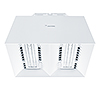 CRAFT
CRAFT
-
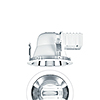 PANOS
PANOS
-
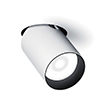 SUPERSYSTEM II
SUPERSYSTEM II
| Architect: | Dinko Peračić (HR) |
In the entrance area it was necessary to generate a welcoming atmosphere and to simplify orientation for people entering the expansive building. The slim TUBILUX tube luminaire proved the ideal option. The height of the rooms played a decisive role in the specification of the lighting for the 94 classrooms and offices. The luminaires, mounted on ceilings with heights of between 4 and 8 metres, had to deliver enough light for the various different visual tasks undertaken by both students and staff. In addition, they needed to simultaneously demonstrate outstanding glare control and contribute to a pleasant atmosphere that is intended to promote learning and concentration. An MPO+ micro-pyramidal optic and perforated side reflector helped the ECOOS fitting catch the eye of the client. The pendant luminaire blends an attractive design with excellent lighting performance.
The addition of LUXMATE DIMLITE further improves the overall energy performance. The basic version of this lighting management system integrates available light and enables daylight-dependent control in each of the 94 classrooms and offices. LITECOM is combined with the modular SEQUENCE adjustable office luminaire in certain conference rooms to offer lighting scenarios tailored to suit particular tasks and situations. The entire building is equipped with the ONLITE RESCLITE safety luminaire. Excellent efficiency and an optimal light distribution mean that relatively few products were required to meet the relevant standards for safety lighting.
Zumtobel. The Light.
share it
-
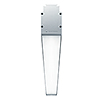 SLOTLIGHT II
SLOTLIGHT II
-
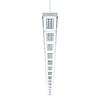 SEQUENCE
SEQUENCE
-
 PERLUCE
PERLUCE
-
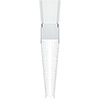 TECTON
TECTON
-
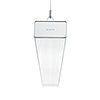 ECOOS
ECOOS
| Owner: | Allreal Generalunternehmung AG, Zurich (CH) |
| Architect: | EM2N ARCHITEKTEN AG, Zurich (CH) |
| Lighting design: | Vogt und Partner, Winterthur (CH) |
| Electrical consultants: | Bürgin und Keller, Adliswil (CH) |
| Electrical installations: | Alpiq InTec Ost AG, Zurich (CH) |
| Photos: | Markus Frietsch |
Industrial charm with new appeal
In 2005, a new way of using the property from the seventies had to be found. It was generally agreed that not just another office complex would be built on this site, right in the heart of Zurich-West, a district that had meanwhile blossomed out into a cultural hotspot boasting the industrial charm of days gone by. Hence, based on a feasibility study, it was determined that the 24,435 m² Toni-Areal was to be transformed into the new central location of the Zurich University of the Arts (ZHdK) and the Zurich University of Applied Sciences (ZHAW). In the subsequently launched architectural competition, the project design submitted by the EM2N architects' studio came out first, and the building application filed in autumn 2007 laid the foundation for the ambitious renovation and new building project involving an investment volume of CHF 350 million.
Right on time for the start of the autumn term in September 2014, approx. 5000 students, lecturers and staff members could move to the new premises. In addition, not only 100 new flats including an accessible roof garden and a car park accommodating 240 cars, but also rooms for exhibitions, events and spaces for commercial use were created. A contemporary infrastructure was developed that not only allows interaction of various disciplines at one location, but also ensures the university's high educational and service quality as well as its international competitiveness.
The design of the campus building picks up the former industrial building's architecture, creating a heterogeneous space where different interests are reconciled, also in terms of lighting. The lighting concept toys with this heterogeneity. Its aim is not to produce uniform brightness, but to have the luminaires arranged so as to divide the space into zones and create a dialogue between light and dark. Also, the lighting solution is as capable of transformation as is the Toni-Areal site itself. On the one hand, ideal lighting conditions for learning and communication are produced; on the other hand, the creative ambience is enhanced and students are provided with the right light for their exhibition areas.
The key role in implementing this lighting solution is played by a modular luminaire system that meets the high demands in terms of flexibility and customisability: TECTON, which is able to fulfil complex functions and a variety of lighting tasks thanks to its versatility, compatibility and expandability within one system. The continuous-row lighting system is based on trunking incorporating an 11-pole current conducting section. All functions such as power supply, lighting control and connection to the emergency lighting system are integrated into this multi-functional trunking unit. In order to illuminate 1400 lecture rooms, seminar and training rooms, more than 33 kilometres of TECTON trunking were installed.
At peak times, more than 600 electricians were working on the construction site, installing more than 5500 TECTON continuous-row luminaires, among others. As required, a variety of optics and louvres were used, which can also easily be replaced or added if the requirements placed on the lighting solution should change.
Zumtobel. The Light.
share it
| Owner: | Projektgesellschaft Wirtschaftsuniversität Wien GmbH, Vienna (AT); Library and Learning Center (LLC): BIG Bundesimmobiliengesellschaft mbH, Vienna (AT) |
| Architect: | LLC: Zaha Hadid Architects, Hamburg (DE) |
| Lighting design: | LLC: Arup, Lighting Design, Berlin (DE) |
| Electrical consultants: | LLC: Vasko + Partner Ingenieure, Vienna (AT) |
| Electrical installations: | ARGE KM/E (Klenk&Meder / EMC), St. Pölten (AT) |
Campus of Knowledge
The centre of the spacious nine hectare campus is the Library & Learning Centre (LLC) designed by Zaha Hadid. With its sharp corners and bold lines the expressive building, which leans forward far over the forecourt, evokes the image of a futuristic command centre. The interior is also dominated by spaceship aesthetics with dramatically slanted walls, rounded edges and long, narrow walkways extending from one end of the room to the other. The LLC is flanked mainly by black & white, plain office and institution buildings. In striking contrast: the Teaching Center (TC), clad in Corten steel, and the red-orange-yellow Institute Cluster designed by Peter Cook.
The heterogeneous styles of the six planning architects also presented a challenge for the light planners. On the one hand it was necessary to adapt the light concept to the particular architectural character, alternating between subdued and dynamic; on the other hand, the number of products had to be reduced to a minimum with a goal towards efficient facility management. The end result: a total of 12,000 luminaires – including pendant luminaires, hidden cove luminaires and numerous individual light solutions – as well as seven kilometres of continuous row lighting.
The entire campus, which currently accommodates about 23,000 students and 1,500 employees, was designed in accordance with the green building concept. Of course, that also means installing efficient and sustainable light products, such as the SLOTLIGHT II light line, the CLARIS II pendant luminaire and LED luminaires of the PANOS INFINITY series. All lighting systems in the buildings are controlled by a common KNX bus controller; motion detectors are used to control the lights in the stairways and sanitary facilities, while the offices are equipped with a special light control system to optimise the use of daylight. In comparison with conventional solutions this combination uses far less energy.
One special aspect of this project: In addition to Zumtobel’s role as a commercial enterprise, the company was also responsible for the entire installation, in the form of a joint venture with four electrical installation companies.
Zumtobel. The Light.
share it
| Owner: | National Aeronautics and Space Research Centre, Cologne (DE) |
| Architect: | Grass Kramer Löbbert and Prof. Uta Graff Architekten, Berlin (DE) |
| Lighting design: | Carpus + Partner AG, Hattersheim (DE) |
| Electrical consultants: | Carpus + Partner AG, Hattersheim (DE) |
| Electrical installations: | R+S Solutions GmbH, Radebeul (DE) |
| Lichtkonzept: | Schlotfeldt Licht, Berlin (DE) |
The Cologne Airport borders directly on the endless expanses of space – although there are no launching pads to be found here, since the travels into the orbit and beyond take place on the ground. Here at the Institute for Aviation and Space Medicine of the DLR National Aeronautics and Space Research Centre, simulations are conducted to test the effects of extended stays on board a spacecraft. Weightlessness is a special focus of the researchers, due to the complex physiological changes it can cause – such as muscle or bone degeneration.
Learning from Outer Space
A new research environment is now available for such studies: the “:envihab”, protected and supplied by an elongated, floating structure with a white, perforated façade directly across from the old institute building on the DLR grounds. The name “:envihab” is a contraction of “environment” and “habitat” and the facility is used for tests such as the “bed rest study” that can last up to three months and places only one requirement on the test subjects:
they have to stay in bed. This requirement is so stringent that the subjects are moved to a special bed when it is time for them to have a shower. And the surface is inclined six degrees so that their heads are lower than their legs at all times – this position is especially favourable for simulating weightlessness, according to the researchers. The wraparound glass strip between the floor and ceiling and the six skylights allow ample daylight to enter the building.
For these “bed rest studies” alone the “:envihab” has twelve rooms, in addition to the afore-mentioned shower rooms, special carts, a completely furnished kitchen and a common room. Although not necessary for lying in bed for extended periods, it is needed for isolation studies on a group scale, simulating long journeys through space.
The “:envihab” sleep and physio-lab also deals with terrestrial matters. It is used, for example, to examine the effects of shift work, lack of sleep or irregular working hours – and the effect of light. The circadian rhythm of daylight defines human waking and sleeping phases – receptors in the retina register the change of short-wave light and control sleepiness by means of melatonin production. In the sleep labs this rhythm can be systematically delayed or even interrupted – in order to observe the effects on well-being, health and performance. The diffuse and variable light needed for these tests is provided by the luminous ceilings equipped with LEDs in the rooms, and also where the test subjects are examined by means of PTE (positron emission tomography) scans.
In cooperation with the DLR Institute Zumtobel developed the modular luminous ceiling, whose CIELOS LED elements can generate precise and dynamic luminous colours and luminances by means of the LITENET control system. The brightness can be dimmed continuously down to a minimum level without flickering and the RGB spectrum can also be varied as needed. The low installation height, durability and user-friendly maintenance were further arguments for an LED luminous ceiling.
The purpose of these circadian studies is not only to examine the interaction of light and the condition or performance of the test subjects, but also to clearly define the qualities of light necessary to prevent fatigue at the workplace or to reduce the effects of jet lag.
Of course, the “:envihab” does not consist only of the sleep and physio-lab; the complex comprises a total of eight research modules under one roof. The architecture is literally based on the house-in-house principle. All of the modules and the large auditorium are designed as separate structures beneath the roof construction, which defines the outward effect of the building and is actually more than just a roof. The steel support structure contains the building’s entire technical infrastructure. This was somewhat of a trick, since the 3,500 square metre interior – rather uncharacteristic for a research facility – presents itself as orderly and clearly structured.
The “:envihab” is also a symbol for a new self-conception in research – in the past, such facilities tended to be purely functional in nature; today, the publicity effect is increasing in importance. In addition to the exterior, this paradigm shift is apparent especially in the interior. The entrance on the ground level is connected by a wide and pleasantly designed stairway to the spacious entry hall. The large auditorium with seating for 150 and the restaurant infrastructure are designed as a location for external events. Although situated below the ground level, the entire interior is surprisingly illuminated by daylight – this is achieved not only by the wraparound glass strip between the floor and ceiling, but especially by a total of six light wells that penetrate the building vertically at different locations, establishing a connection with the sky – in keeping with the central theme of the DRL, which the architects adroitly interpreted.
The incompatibility of public utilisation with sensitive fundamental research necessitated a separation of the two areas by means of a partition. But since they are made of glass, the room volume can be experienced in its entirety together with the individual modules. In the centre, for example, there is a cylindrical module with solid concrete walls, with a short-arm centrifuge inside. This apparatus is used to explore whether increased gravity can be used selectively to counter the health risks of weightlessness. Initially in relation to long-term stays in space, the results will also bring new insight into down-to-earth issues such as osteoporosis, muscle degeneration and circulatory disorders.
Zumtobel. The Light.
share it
-
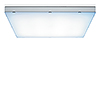 CIELOS
CIELOS
-
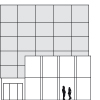 LUXMATE LITENET
LUXMATE LITENET
| Owner: | Bau- und Liegenschaftsbetrieb NRW, branch office Aachen (DE) |
| Architect: | Lepel & Lepel Architektur Innenarchitektur, Cologne (DE) |
| Lighting design: | a•g Licht GbR, Bonn (DE) |
| Electrical consultants: | ZWP Ingenieur-AG, Cologne(DE) |
The curved administrative building with its Z-shaped ground plan offers maximum flexibility in the interior. Since it is already apparent today that the administrative and instructional requirements can change in the future, the widespanned supporting structure allows for different room layouts. The wraparound façade banners emphasise the horizontal structure and universal usability of the building.
The high windows allow ample daylight to enter from all sides to ensure even illumination of the office areas. For supplemental illumination of the workplaces with artificial light the architects sought a solution that supports the desired flexibility in the spatial layout while enhancing the formal, reductionist design of the building. Together with the agency a∙g Licht based in Bonn a product was found that optimally fulfils all of the required criteria: ECOOS. The building owner was convinced not only by the high-quality light, but especially also by the long-term lower operating costs.
By way of complete contrast, the motor test centre is an introverted, elongated hall structure. The façade of darkened fairfaced concrete with only narrow slit windows emphasises this character. Inside, the building is rigidly organised, structured and adapted to the spatial and technical conditions of the test equipment. Despite the narrow windows, which make it possible to see the interior from outside, rows of windows in the roof allow sufficient daylight to enter the two-storey hall. The TECTON continuous row lighting system provides for optimal workplace lighting and orientation. Time-tested in industrial use, TECTON combines all of the elements needed here: optimal lighting quality even from large heights, flexible utilisation of space, high efficiency and easy maintenance.
A special feature is the advanced energy concept: the enormous waste of heat generated by the motor test runs can be used to heat the building. A foresighted approach to efficient reuse of energy, which benefits man and the environment.
Zumtobel. The Light.
share it
| Owner: | The University of Melbourne, Melbourne (AU) |
| Architect: | Grimshaw Billard Leece, Melbourne (AU) |
| Lighting design: | S2F/SKM, Melbourne (AU) |
Das kürzlich fertiggestellte Peter Doherty Institute, das auf der südlichen Hemisphäre als einziges Forschungsinstitut seiner Art gilt, wurde mit dem Fünfsterne-„Green Star“ ausgezeichnet.
„In einem komplexen Laborgebäude wie diesem ist der Stromverbrauch fünf- bis zehnmal höher als in einem herkömmlichen Bürobau”, sagt Chris White, Executive Director of Property and Campus Services an der University of Melbourne. „Daher ist es bei diesem Bauwerk sehr wichtig, einen entscheidenden Beitrag zur Energie- und Ressourceneinsparung zu leisten.“ Das Resultat ist ein zehnstöckiges High-Tech-Gebäude mit 25.000 Quadratmetern Nutzfläche, Kraft-Wärme-Kopplung, Grauwassernutzung und begrünter Dachlandschaft. Das Peter Doherty Institute ist so konstruiert, dass es gut 50 % weniger Strom als ein ähnlich angelegtes Objekt vergleichbarer Größe verbraucht.
Die Planer hinter diesem hocheffizienten Bauwerk, das an der sonnenzugewandten Nordseite mit einer doppelschaligen Vorhang-Fassade verkleidet ist, sind die international agierenden Grimshaw Architects in Zusammenarbeit mit der auf Forschungs- und Gesundheitseinrichtungen spezialisierten Akademie Billard Leece. Auf produktionsintensive Materialien wie Aluminium wurde nach Möglichkeit verzichtet, stattdessen wurde beim Bau FSC-zertifiziertes Holz im Wert von 5,2 Millionen US-Dollar integriert. Außerdem maximiert die Konstruktion die Tageslichtnutzung soweit wie möglich. Nicht so in einigen Laboren.
Forschen wie unter Tageslicht
Die strengen Anforderungen in einigen Bereichen erforderten eine weitestgehende Vermeidung von Tageslicht. Eingesetzt wurden daher rund 2.000 Büroleuchten MILDES LICHT V. Mit 1,25 Watt und 100 Lux pro Quadratmeter sind die Einbauleuchten so konfiguriert und positioniert, dass der Eindruck von hellem, durch Dachfenster fallendem Sonnenlicht entsteht. Denn für die rund 700 Forscherinnen und Forscher, die am „Doherty“ arbeiten, ist es notwendig, bestmögliche, freundliche und die Konzentration und Motivation fördernde Arbeitsbedingungen zu schaffen.
In den übrigen Bereichen des „Doherty“ wurden dezente, harmonische Lichtquellen genutzt. Die Herausforderung lag darin, Licht und Schatten zu begrenzen, um die fließende Geometrie hervorzuheben und die visuelle Wirkung der organisch geformten Holzrippen zu verstärken. Eingesetzt wurden ausschließlich natürliche Materialien. Linear angeordnete Leuchten betonen die organischen Formen, die einen Ausgleich zum schlichten und zweckmäßigen Design der Labore herstellen.
Zumtobel. Das Licht.
share it
| Owner: | Akademiska Hus, Solna (SE) |
| Architect: | Metod Arkitekter AB, Uppsala (SE) |
| Lighting design: | MIAB/Tyréns AB Simon Baczkowski, Stockholm (SE) |
| Electrical consultants: | MIAB/Tyréns AB Simon Baczkowski, Stockholm (SE) |
| Electrical installations: | Ohmegi Elektro AB, Sollentuna (SE) |
In this context, the lighting system, too, becomes increasingly important. The lessons held in sign language are supported by well-balanced and glare-free illumination of the classrooms. What is even more important: the luminaire drivers must be absolutely noiseless, since otherwise interferences with the students' hearing aids would occur. Following various tests involving a number of products, it turned out that LIGHT FIELDS LED were the only luminaires that met all these requirements.
The Manillaskolan is now accommodated in a new location in Kungsholmen, a borough in central Stockholm. Here a campus has been built that includes a number of schools and special educational facilities in buildings formerly housing institutes of Stockholm University. Even before the refurbishment, students, teachers and parents were given the opportunity to visit trial classrooms and discuss their expectations and needs. Thus, the students are now provided with facilities that are up to date, versatile and ideally suited to their needs.
share it
| Owner: | EFF, Reykjavik (IS) |
| Architect: | Henning Larsen Architects, Kopenhagen (DK); ARKIS Architects, Reykjavik (IS) |
| Lighting design: | VERKIS, Reykjavik (IS) |
| Electrical installations: | Rafmiolum hf, Reykjavik (IS) |
Situated halfway between Europe's and North America's established science centres, Reykjavik University is turning into a new research and technology top spot. Its architectural design, too, deserves special attention: the individual faculties are arranged radially around a circular hub. The campus opens up in a fan-shaped manner towards the beach and forest areas surrounding it, incorporating them into the premises. Apart from endowing all of the rooms with the unique quality of a natural environment, this layout also permits optimum illumination and heating with natural daylight - a crucial aspect of the sustainability of the building, in which trendsetting technologies are not only part of everyday life but are also part of the curriculum.
For the major part of the building, the engineers developed a ceiling system made of perforated sheet steel blades, which was also intended to accommodate the lighting system. In order to meet the vast range of requirements in the best possible manner, the client organised a competition. Zumtobel's most convincing point: despite its small dimensions and the fact that it fully met glare control requirements, the T5 luminaire's light output ratio could be improved by more than 1.5 percent compared with standard technologies. This has been made possible by translucent lateral reflectors, optimised miniature louvres and a perfect lamp operating temperature. From the design point of view, the luminaire could not fail to impress on account of its modular system that is able to adjust to a variety of visual tasks in lecture halls, seminar rooms, offices, libraries and circulation areas - mounted on a gear tray, installed as a wallwasher or as a model with open light distribution.
The LUXMATE LITENET lighting and blinds control system has been developed further to take account of the special local lighting conditions characterised by the Nordic sun's shallow-angle radiation over long periods of time. In this way, high efficiency and maximum comfort were combined with the option of responding flexibly to changing area-use plans, with minimum effort. Most of the luminaires were supplied with so-called Dimming On Demand (DOD) ballasts, allowing for major cost savings as a large number of luminaires were installed.
Zumtobel. The Light.
share it
-
 PERLUCE
PERLUCE
-
 LUXMATE LITENET
LUXMATE LITENET
| Owner: | Losinger Construction SA, Bussigny (CH) |
| Architect: | SANAA, Tokio (JP) |
| Electrical consultants: | Scherler SA, Le Mont/Lausanne (CH) |
| Electrical installations: | ETF, Bulle (CH) |
With its translucent skins and round patios, the pavilion designed by SANAA is the new heart of the École Polytechnique Féderále de Lausanne's campus. In an area of 17,000 m², it accommodates a library, conference rooms, students' workstations, offices for researchers, cafeterias, a top restaurant, a book store, a multifunctional auditorium and - very Swiss - a branch bank. However, the Pritzker Prize-winning architects had definitely more in mind than providing functional rooms. The new building is meant to foster interdisciplinary exchange among scientists, and above all seeks to establish an appropriate position for EPFL in the global research scene.
The building is made up of a single large-scale room with casually arranged functional areas, radiating impressive openness. The dynamic topography of the floor and ceiling creates a fascinating roomscape, divided into zones by a variety of lighting scenes. In the process, the ceiling is not only changed by daylight but also reflects the artificial lighting back into the room. The building is certified according to the Minergie standard, and luminaires with a very high output ratio had to be installed because of the building's size and in line with SANAA's request for indirect lighting.
The specially developed luminaires have been installed as individual luminaires or in twin or triplet configurations, allowing to create any lighting situation required by using a single creative design element. Thanks to the luminaires' flexible fixture, a variety of different angles can be set in relation to the diffusely reflecting ceiling. Many of the total of 282 custom luminaires have been fitted with an extra 100 W halogen lamp for emergency lighting purposes, in addition to a 35 W HIT metal halide lamp with a special IOS reflector system. In the lobby and reception area, LED downlights and elegant light lines additionally provide functional lighting while setting creative accents. In the offices, which have been designed as circular booths, minimalist free-standing luminaires create a pleasant working atmosphere.
Zumtobel. The Light.
share it
-
 FREELINE
FREELINE
-
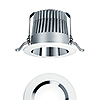 CRAYON
CRAYON
-
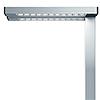 MINIUM LIGHT
MINIUM LIGHT
-
 SLOTLIGHT II
SLOTLIGHT II
| Owner: | Tomáš-Bata-Universität, Zlín (CZ) |
| Architect: | Al Design s.r.o. und Eva Jiricna Architects, Prag (CZ) |
The new university centre of the Tomá Bata University in Zlín is a symbol of the city's investment into its citizens and their future – and an appropriate tribute to the visionary ideals of the philantropist and industrialist after whom it was named.
The building's extraordinary structure is based on two crescent-shaped units accommodating the reading rooms, classrooms and book archives. Between the units there is a spacious atrium lit from the top where people find space to relax. The staircase towers located at both ends of the curved façade form the main vertical link between the galleries along both sides of the atrium, giving the building an uncluttered, practical look. This very clear design, which is typical of architect Eva Jiřičná, with maximum functionality is also reflected in the lighting system.
The clear lines of the building are emphasized by equally clear SLOTLINE light lines installed in the rooms. Thanks to its calm, geometrical stylistic idiom, CLARIS II, which is frequently used in school buildings, could not fail to impress either. In the centrally located atrium, it has been installed as a continuous row system with a total length of 54 m. Both direct and indirect light is provided throughout the room, providing a uniform, warm and diffuse lighting scene. In the other main areas, SLOTLIGHT and MIREL II lighting systems have been installed to supplement the light reflected by the atrium. MIREL II louvre luminaires assembled to form architecturally striking light lines provide uniform, glare-free lighting for the libraries and computer workstations.
For highlighting the edges and lines along the windows and peripheral areas, fluorescent lamps have been recessed into the ceilings and walls, underlining the sculptural interior design. The Tomá Bata University is a trendsetting example of how to perfectly integrate lighting into a design concept.
Zumtobel. The Light.
share it
-
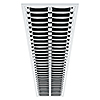 MIREL T16
MIREL T16
-
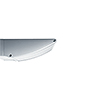 LANOS
LANOS
-
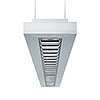 CLARIS II
CLARIS II
-
 SLOTLIGHT II
SLOTLIGHT II
-
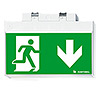 ONLITE ECOSIGN
ONLITE ECOSIGN
-
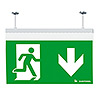 ONLITE COMSIGN II
ONLITE COMSIGN II
-
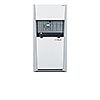 ONLITE CENTRAL
ONLITE CENTRAL
| Owner: | Royal Northern College of Music, Manchester (GB) |
| Architect: | MBLA Architects + Urbanists, Manchester (GB) |
| Electrical consultants: | Gifford and Partners, Manchester (GB) |
The striking new building of the Royal Northern College of Music in Manchester's city centre attracts attention. Cubes nested into each other demonstrate monumental geometry seemingly in contrast with the building's purpose - the lightness of music. The building's very small floor area has been used to optimum effect by adding an acoustic buffer against traffic noise doubling up as a shop window for the college. Additional appeal is achieved by lighting in variable colours, which turns the space into a glowing light box with spectacular colour changes, attracting the attention of passers-by. Inside, the lighting system is supplemented by the flush-mounted LIGHTTOOLS lighting channel system incorporating four different lighting modules: spotlights, downlights, linear luminaires and wallwashers.
In almost every area, large windows and skylights allow plenty of daylight to enter the room. Where this is not sufficient, artifical lighting is added via the lighting management system. In concert with pleasant colours and ergonomically compatible furniture, rooms of experience are created that make students want to learn - flexibly and conveniently, and with a focus on saving resources.
According to Craig Jackson from Gifford and Partners, who specified the lighting, the lighting design was strongly influenced by the acoustically sensitive environment. “The luminaires must be robust and without parts which could reverberate from the sound of the instruments,” says Jackson. This special challenge has been met by the LIGHTFIELDS recessed luminaire, which, due to its special micro-pyramidal optic, provides extremely uniform, glare-free light, helping to increase the brilliant young students' concentration.
Zumtobel. The Light.
share it
-
 2LIGHT
2LIGHT
-
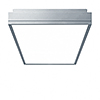 LIGHT FIELDS
LIGHT FIELDS
-
 PANOS
PANOS
-
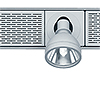 LIGHTTOOLS
LIGHTTOOLS
-
 CLARIS II
CLARIS II
| Owner: | KHBO, Katholieke Hogeschool, Brugge Oostende (BE) |
| Architect: | Tijdelijke Vereniging S.A.R. – De Vloed, Heusden-Destelbergen (BE) |
| Electrical consultants: | Studiebureau De Klerck Engineering, Brügge (BE) |
| Electrical installations: | Electro Entreprise NV, Gullegem (BE) |
The new building of the Catholic University College in Bruges is a landmark characterised by architectural contradictions. The façade towards the street is closed, featuring only a single window in the study department, while the façade towards the campus presents itself extremely open. Exciting contrasts are created by a combination of steel, glass, concrete and wood. At the same time, the modular approach allows for adjusting the building to new studying requirements in the future.
The atrium has been designed as a three-dimensional junction featuring wide stairs, open galleries as well as seating areas and islands for studying. According to the architects' preferences, the building was to be fitted mainly with indirect lighting. The MIROS projector-mirror system provides an architecturally sophisticated and technically perfect lighting solution, illuminating the up to 10 m high rooms with uniform, glare-free light. The system's warm light creates a fascinating contrast to the rather cool concrete/glass architecture. Concludes Koen De Klerck: "Using both functional and atmospheric lighting we have sought to enhance the architecture and the building's surroundings even further. In the process, both flexibility and maintenance aspects have been taken into account." The projector-mirror system appears to be part of the building design, and has also been installed in the two auditoriums and the cafeteria.
The lecture halls and seminar rooms, which are accommodated in the three striking blocks, can be reached via the auditorium. In the classrooms, MIREL recessed luminaires installed flush in the ceiling provide plenty of light. In the circulation areas, a special section with indirect distribution provides pleasant, glare-free light.
Zumtobel. The Light.
share it
-
 MIREL T16
MIREL T16
-
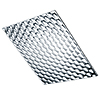 MIROS
MIROS
| Owner: | Hogeschool Gent, Campus Schoonmeersen (OLC), Gent (BE) |
| Architect: | cv baro, Gent (BE) |
| Electrical installations: | Technum, Sint-Denijs-Westr (BE) |
The latest showcase project of Gent University was designed by architects from the cv baro studio: in addition to a number of flats, Schoonmeersen Campus also accommodates several cafeterias and the Hogeschool’s sports centre.
The clients opted for the TECTON continuous-row lighting system to be installed in large areas of the building complex. Fitted with high-quality matt reflector optics, the continuous-row lighting system provides pleasant lighting conditions in classrooms and auditoriums, as well as in the reception area and in the library. All these rooms are fitted with suspended acoustic ceiling panels. This is why it would have been very difficult to use conventional recessed luminaires, which would also have required considerable compromise in terms of design. The flexible TECTON continuous-row lighting system proved to be the ideal solution. Like the acoustic ceiling panels, the track system can be suspended as well, so that the luminaires now match the architecture perfectly.
The TECTON lighting system installed at Gent University creates optimum lighting conditions in classrooms, and is also highly efficient.
Another argument in favour of TECTON is its pre-wired eleven-pole track: using the integrated DALI bus line, the luminaires installed in the library and the cafeteria enable daylight-based lighting control. The result is a lighting solution controlled via LUXMATE PROFESSIONAL which provides a pleasant lighting atmosphere 24 hours a day and at the same time reduces energy consumption considerably. In order to keep maintenance costs as low as possible, projector/mirror systems were installed in the entrance area and the five-metre high corridor zones, which allowed to mount the spotlights used at an accessible height so that only a minimum of time is required for relamping.
Quite different, however, is the situation in the cafeteria. Thanks to modern furniture and green transparent chairs, a playful touch is added to these areas – also because of the COPA D high-bay reflector luminaire used. The large roof protecting the footpath between the two buildings of Schoonmersen Campus is illuminated by high-pressure halogen spotlights and RAIN moisture-proof luminaires.
Zumtobel. The Light.
share it
-
 MIROS
MIROS
-
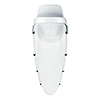 SCUBA
SCUBA
-
 PANOS
PANOS
-
 TECTON
TECTON
-
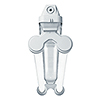 RAIN
RAIN
-
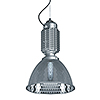 COPA
COPA
-
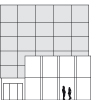 LUXMATE PROFESSIONAL
LUXMATE PROFESSIONAL
| Owner: | The Cooper Union for the Advancement of Science and Art, New York (US) |
| Architect: | Morphosis Architects, Los Angeles, New York (US) |
| Lighting design: | Horton Lees Brogden Lighting Design, Los Angeles (US) |
The new university building of the Cooper Union located in New York's East Village presents itself as an angular metal structure. The spectacular architecture designed by Pritzker Prize winner Thom Mayne boasts a lighting system based on an equally fascinating lighting design. During the day, the structure shines in white to metal anthracite grey; at night, it softly glows from inside.
This work by the California-based architect creates controversy among New Yorkers, breaking established conventions and being ahead of the times. As a sign of provocation, for instance, Mayne has made the elevator stop only on three out of nine floors. This feature ultimately directs the students' and visitors' attention towards the staircase, unless they have not been attracted earlier by its breathtaking architecture. Like a huge vortex, it ascends upwards across all the floors, opening up towards the sky. Through a large skylight, daylight enters and floods down right to the ground floor.
The upper floors are therefore flooded with bluish daylight, which, as it travels downwards, gradually mixes with increasingly warm artificial lighting provided by VIVO spotlights.
In the other areas of the building, the lighting concept is based on specific functions. In the laboratories, for instance, twice as many light sources have been used as in the seminar rooms, in order to make subtle colours differences and details more easily perceptible. The seminar rooms and numerous laboratories presented a special technical lighting challenge: the luminous panels installed in the ceiling had to be integrated in the heating and cooling modules also installed in the ceiling. A tricky task, yet readily taken care of on account of the building's general environmental compatibility. With this design, Thom Mayne has set new standards, not only in terms of visual attraction. As the first university building in the USA, the new Cooper Union building is about to receive the LEED Platinum Award, the country's most important environmental compatibility prize.
Zumtobel. The Light.
share it
-
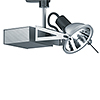 SPIRIT
SPIRIT
-
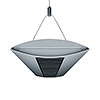 SPHEROS T16
SPHEROS T16
| Owner: | Cité d’Architecture et du Patrimoine (FR) |
| Architect: | Agence Bodin, Paris (FR) |
| Lighting design: | Agence Bodin, Paris (FR) |
| Electrical consultants: | GEC Ingenierie, Paris (FR) |
There are not many venues dedicated so completely to architecture and showing this in such an impressive way like the modern neo-classical Palais Chaillot on the Seine. Following careful renovation, the world's largest Architecture Centre was opened in the building's magnificent east wing in 2007. Since then, the prestigious building has accommodated several institutions that bring historical and modern architecture and France's cultural heritage together under one roof.
The lighting design of the spacious entrance hall on the ground floor imparts this area with a clear structure, enhancing visitor orientation and centralising access to the various areas. The light lines set in the ceiling trace the main axes of the hall along the monumental columns.
The open-access library with its high-ceilinged, flowing rooms houses some 28,000 books. Jean Francois Bodin has managed, without major interference with the fabric of the building, to create a functional, contemporary library interior. The reconstructed fresco cycle from Saint Savin sur Gartempe Abbey has been set centre stage using a luminaire especially developed for this purpose. The barrel vault of the 40 m long room is flooded by warm light provided by reflectors based on the TECTON system, which have been installed above the shelves on the wall.
The impressive gallery of architecture expands across the curved room occupying the complete second floor of the wide building tract. The central exhibition area is illuminated uniformly by seven large, backlit ceiling rotundas; the lighting can be controlled to provide a variety of illuminance levels, if required.
Zumtobel. The Light.

